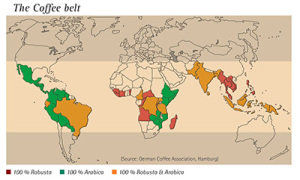 As legend has it, you can thank shepherds in Ethiopia who first recognized the rejuvenating power of coffee when their goats became more energized after eating coffee beans.
As legend has it, you can thank shepherds in Ethiopia who first recognized the rejuvenating power of coffee when their goats became more energized after eating coffee beans.
So join me in celebrating the first official International Coffee Day today, October 1, 2015!
Coffee is a cross-cultural relationship builder—and not just in the coffee belt where it is grown. From Argentina to Vietnam, Austria to the United States, the 75 member states of the International Coffee Organization are helping to spread the word about the pleasures and benefits of drinking coffee. In Columbia, for example, the event is not just for the day, but will be a month-long celebration. There’s also a full week of activities planned in Tokyo, Japan, hosted by the Ministry of Agriculture, Forest & Fisheries.
When dining with international business counterparts, business may not be discussed until after dinner. Once the coffee is poured, discussion begins in earnest. When asked “would you like coffee?” keep these international protocol concepts in mind:
- Coffee is a symbol of hospitality
- Accept an offer of a cup of coffee from your host or hostess
- An offer of coffee signals a desire to visit and engage in conversation
- Declining coffee signals the relationship is unimportant
- Don’t drink coffee? Allow a cup to be poured and leave it to cool
- Sugar goes in before cream, as it dissolves faster in hot coffee
- Requesting decaffeinated coffee is acceptable
- Requesting cappuccino or latte when it is not offered is inappropriate
- Turning your coffee cup upside down is for hotel staff to do – not you
- When drinking bottled iced coffee, pour it into a cup or glass
- Drinking coffee from a bottle or while walking down the street is taboo
Did you know that, according to the USDA’s Foreign Agricultural Service’s Office of Global Analysis report for June 2015, of the top 15 coffee producing countries, eight of them are in Central or South America (collectively known as “Latin America”)? These are: Brazil; Columbia; Costa Rica; Guatemala; Honduras; Mexico; Nicaragua; and Peru.
Or that the European Union accounts for almost 50% of the world’s coffee bean imports (some 45.5 million bags annually)?
As far as the United States is concerned, we import the second largest amount of coffee beans (expected to reach 24 million bags annually) from top suppliers Brazil, Columbia and Vietnam. Indeed, international organization, Global Exchange reports that, “Coffee is the US’s largest food import and second most valuable commodity only after oil.”
One surprising fact, given the appearance of Starbucks on just about every street corner, is that of the 10,000 coffee cafes and 2,500 specialty stores in the U.S., less than a third of these are national brands. The vast majority are run independently!
Where does your favorite coffee come from? Take a few minutes today to sit back, enjoy a cup and dream about sipping coffee somewhere overseas.
Sharon Schweitzer, J.D., is a cross-cultural consultant, an international protocol expert and the founder of Protocol & Etiquette Worldwide. Schweitzer is accredited in intercultural management, is a regular on-air contributor and has been quoted by Investor’s Business Daily, the New York Times and the Bangkok Post. She is the best-selling, international award-winning author of Access to Asia: Your Multicultural Business Guide. For more of Sharon’s insight, follow her on www.twitter.com/austinprotocol and www.facebook.com/protocolww
Photo credit: ©GERMAN COFFEE ASSOC, HAMBURG

Leave A Comment